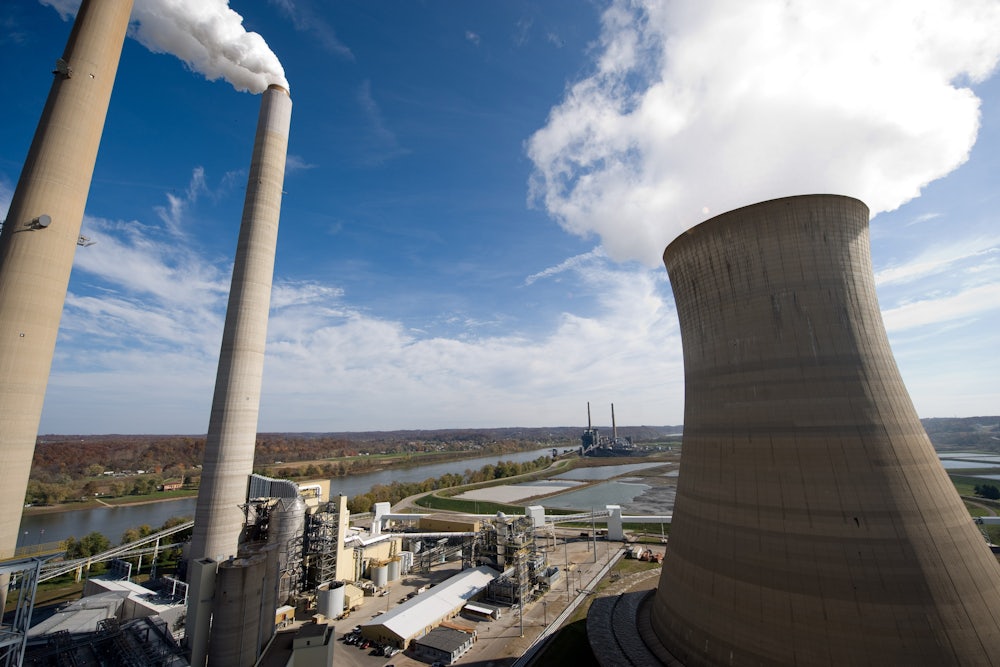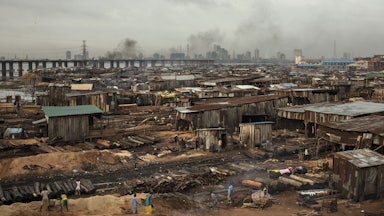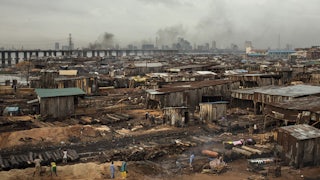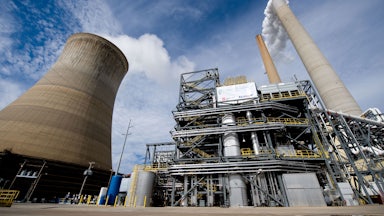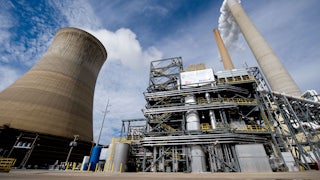In 1948, when the amount of carbon dioxide in our atmosphere stood at only 310.5 parts per million, the sociologist Robert Merton coined the term “self-fulfilling prophecy.” Merton used the term to describe how racist beliefs produce institutional bias and justify underinvestment in the education of Black children, which can lead to their academic underachievement compared to white children—which then seems to confirm the racist bias that itself produces the outcome. “This specious validity of the self-fulfilling prophecy perpetuates a reign of error,” Morton wrote, “for the prophet will cite the actual course of events as proof that he was right from the very beginning.”
Today, self-fulfilling prophecies are making the climate crisis worse. Perhaps one of the best examples—a prophecy that helps produce and justify the continuance of the fossil fuel system—is a seemingly simple claim: “We need carbon dioxide removal.” For example: “It is well understood that we need to cut greenhouse gas emissions and transition to new systems of energy, food, and waste management. However, to limit warming to ambitious 1.5° Celsius or 2° Celsius targets [around 2.7 and 3.6 degrees Fahrenheit, respectively] we also need to remove massive amounts of carbon dioxide from the atmosphere.” So says The CDR Primer, a website written—with help from the P.R. firm Spitfire Strategies—by a group of scientists, engineers, sociologists, and businesspeople who advocate centering carbon dioxide removal, or CDR, techniques in climate policy. These techniques include “nature-based” solutions such as reforestation but also speculative chemical-mechanical technologies, such as bioenergy with carbon capture and storage, or BECCS, and direct air capture, or DAC.
The phrase “we need CDR” may sound less like a prophecy and more like a description of the situation. It is true that, having continued to use fossil fuels, the world is on the threshold of global warming of 1.5 degrees Celsius. It seems likely we will cross this threshold sometime between 2025 and 2044. If this happens, the only way to cool the planet back down would be to permanently remove hundreds of gigatons of carbon from the atmosphere. This is why the Intergovernmental Panel on Climate Change reported today, in the third part of its Sixth Assessment Report, that CDR “is an essential element of scenarios that limit warming to 1.5° C.”
But part of the reason we are about to exceed 1.5 degrees Celsius is that these scenarios have acted as self-fulfilling prophesies. The scenarios have created the whole idea of carbon removal to show policymakers how we could continue to use fossil fuels and, supposedly, still hit our climate targets by “reversing” global heating with massive amounts of CDR technology. Instead of modeling how to stop using coal, oil, and gas in time to halt warming directly, they have told policymakers “we need CDR,” offering maps that have led us right to the levels of warming we will see in the coming decades.
But the models saying “we need CDR” are not establishing scientific facts. They are positing political futures. Known as “integrated assessment models,” or IAMs, they combine physical science with economic inputs in order to find the most cost-effective, optimized pathway to a temperature target. IAMs are related to the cost-benefit “Dynamic Integrated Climate Economy,” or DICE, model created by the economist William Nordhaus. Nordhaus notoriously uses DICE to find that delaying the end of the fossil fuel system long enough to allow our planet to heat three degrees Celsius creates an “optimal” balance between the costs of climate policy and the costs of climate change itself. (I say “notoriously” because the many people likely to die with three degrees of warming might disagree with Nordhaus’s idea of what is “optimal.”)
The mitigation scenarios cited by the IPCC also try to optimize costs using Nordhausian assumptions. The difference is that they also have an externally imposed goal of lower temperature targets. This imposed goal forces the models to hypothesize deployment of CDR at multigigaton scales in the second half of the twenty-first century in order to erase the emissions that will have been generated by the continuance of the fossil fuel system. In other words, they posit reaching a temperature target of 1.5 degree Celsius using some reforestation and massive amounts of BECCS because their assumptions produce extended emissions and then massive CDR deployment, which they interpret as being more “cost effective” than immediate decarbonization. (And BECCS is particularly attractive to these models because they see it as producing energy, in the form of biofuels, on the way to drawing carbon out of the atmosphere.)
But this understanding of what is “cost-effective” depends on lots of assumptions. Like Nordhaus’s DICE model, the IPCC’s integrated assessment models are “perfect foresight” models, which is to say they model CDR as if we already know that it will work at scale. The models aren’t pricing in the risk that CDR might fail. Nor do they price the risks of the way that building and deploying planetary-scale CDR might compete with other industries or constrain energy supplies. They don’t consider the possibility that global heating might lead to fire or flood destroying bioenergy crops, making CDR itself more expensive and difficult. The integrated assessment models also assume that the economy is and will remain at full capacity, frictionless, and cost-optimized. And they take for granted the economy will continue to grow exponentially despite global heating, because they estimate climate damages will cost only a few percentage points on the margins. And so they imagine that everyone will be richer later this century, which allows them to find that removing carbon dioxide later will be relatively cheaper than phasing out fossil fuels now.
These models calculate fossil fuel phaseout to be so expensive because they represent all of climate policy with a simple carbon tax—the one measure that would likely contract economic growth. And they model this tax as slowly ramping up on a trajectory that supposedly finds an “optimal” balance between the costs of climate policy and the costs of climate damages, which they lowball. Models with different inputs find that warming can be held at well below two degrees Celsius more cheaply overall, and with much lower CDR deployment, if carbon prices start high and then drop as the risk of climate change goes down. Finally, like Nordhaus’s DICE, the mitigation scenarios in the IPCC report vastly overestimate the price of renewable energy, which has dropped so precipitously that solar is now the cheapest electricity in history. When renewables are priced accurately in mitigation scenarios, the value of CDR drops up to 96 percent, depending on the energy system sector under consideration. The lead author of the IPCC’s Special Report on 1.5° C, Joeri Rogelj, admitted in 2019 that “the perceived linkage between end-of-century outcomes and the amount of [CDR] is not robust; instead it is to a large degree driven by the design characteristics that underlie the cohort of scenarios that is currently available in the literature.”
So what’s wrong with the path the models suggest? Why shouldn’t we continue to use fossil fuels for several decades and even allow our climate to heat up past 1.5 degrees Celsius and two degrees Celsius, and simply “reverse” global heating after 2050 with planetary-scale carbon dioxide removal?
Put simply: It’s not at all clear that planetary-scale carbon dioxide removal will work. The BECCS approach, in particular, would create huge land-use problems. The National Academies of Science, Engineering, and Medicine, or NASEM, reports that to remove 10 gigatons of CO2 a year from the atmosphere—about a quarter of global annual emissions—we would have to grow grasses on a land area about one and a half times the size of India. This is nearly half the land area on which the whole planet grows food. Deploying BECCS on huge swaths of land would cause world hunger to rise sharply—and that’s in addition to BECC’s effects on freshwater supplies and biodiversity.
Direct air capture has problems, too. The NASEM estimates that running enough DAC to capture 1,000 tons of CO2, less than one second of current annual emissions, would require so much energy that we would need to site both methane-gas plants and solar panels on anywhere from 1,355 to 2,450 acres (assuming no space in the direct air capture plant footprint can accommodate power-generation equipment). To give you a sense of the scale: A football field is 1.32 acres. New York’s Central Park is 843 acres. All this land to capture less than one second’s worth of current annual CO2 emissions.
The limits to large-scale carbon dioxide removal have led scientific bodies worldwide, including the IPCC, increasingly to warn policymakers against relying on CDR to help the world meet its temperature targets. The European Academies’ Science Advisory Council is quite blunt: “Having reviewed the scientific evidence on several possible options for CO2 removal ... we conclude that these technologies offer only limited realistic potential to remove carbon from the atmosphere.” The IPCC isn’t as blunt, but it too urges policymakers and the public not to rely on CDR. In its 2018 Special Report on 1.5° C, the IPCC warned that “CDR deployed at scale is unproven and reliance on such technology is a major risk in the ability to limit warming to 1.5°C.” And in the first section of its Sixth Assessment Report, on the physical science of climate change, it notes that “CDR removal technologies are not yet ready or are unable to achieve the scale of removal that would be required to compensate for current levels of emissions and most have undesired side effects.”
These statements, of course, seem to contradict the counsel that the models implicitly provide to stakeholders and policymakers. But it’s important to remember that these models are not intended to provide counsel—let alone prophesy. Rather, they are intended to be, as the IPCC says, “policy relevant, not policy prescriptive.” Indeed many scientists and economists who responded to a recent survey of IAM modelers were eager to clarify that their work is “explorative” rather than “predictive” and should not be taken to prescribe “the eventual deployment of BECCS or negative emissions.” Detlef van Vuuren, a scientist and modeler at the Netherlands Environmental Assessment Agency and a board member with the Integrated Assessment Modelling Consortium, once told a reporter, with some impatience, that IAM modeling is “just an element, a tool to explore different trajectories on the basis of the knowledge we have today and to see what kind of things we might encounter.”
Yet policymakers do not always see IAMs as hypothetical explorations. Instead, they tend to see them as maps to the future. A 2021 Congressional Research Service report on climate scenario modeling, for instance, advises that the IPCC’s mitigation scenarios may “provide a foundation for Members of Congress who are considering climate change mitigation proposals,” because they are “specifically designed to find technology deployments that meet specified climate or emissions constraints, typically in a lowest-cost manner.”
Policymakers, corporate stakeholders, journalists, and voters often read scientific speech, even the indirect speech of scientific-economic models, in ways that scientists do not intend. That seems to be what’s happening with the IPCC models: Many people seem to be developing, and proceeding under, the false belief that we can keep using fossil fuels and then deploy CDR in order to halt or reverse global heating. Then when the world is indeed about to overshoot 1.5 and then two degrees Celsius, the prophecy is fulfilled, as it were, and the “need” for CDR becomes real—even though there are basic, planetary limits on what BECCS and DAC can accomplish.
Luckily, scenario modelers have started setting out maps to guide us to 1.5 and two degrees Celsius without temperature overshoot. In one recent study, Rogelj, for example, finds that asking the model to constrain warming, rather than find the most cost-effective pathway to a temperature target in 2100, enables it to achieve net-zero in 2050 and halt warming at 1.6 degrees Celsius without overshoot. The Sixth Assessment Report itself says that to have a 50-50 chance to halt warming at 1.5 degrees Celsius without deploying CDR for overshoot, we would have to reach net-zero emissions by 2044. A 66 percent chance at two degrees Celsius requires net-zero at 2077.
To be sure, our economy will need some CDR to remove essential emissions from the atmosphere and sustain net-zero emissions—perhaps one or 1.5 gigatons a year, which would itself be very challenging but perhaps still feasible from an energy and land-use perspective. We will need to use hydrocarbons to build out clean-energy infrastructure and to make plastics for, say, N95 masks and other medical applications. But a goal of climate policy should be to foster innovation not just in carbon dioxide removal but in industrial materials production—as well as in infrastructure and governance—so that climate-safe behaviors become the global norm. For we also have these tools at our disposal: A phaseout of livestock production, for example, would, through the end of the century, have the same cumulative effect as a 25 gigaton-per-year reduction in anthropogenic CO2 emissions. Even a mere reduction in meat production would help enormously.
We must use all our tools to halt global heating and ensure our children’s futures. But what we must not do, now that we are on the precipice of 1.5 degrees of warming, is bet the planet on carbon removal. The whole idea of carbon removal was developed to keep the fossil fuel system going. In order to dismantle this system, we need to start by removing its conceptual supports. We need to change our erroneous belief that we need CDR before the self-fulfilling prophecy of neoliberal mitigation modeling helps create a catastrophic reality.
